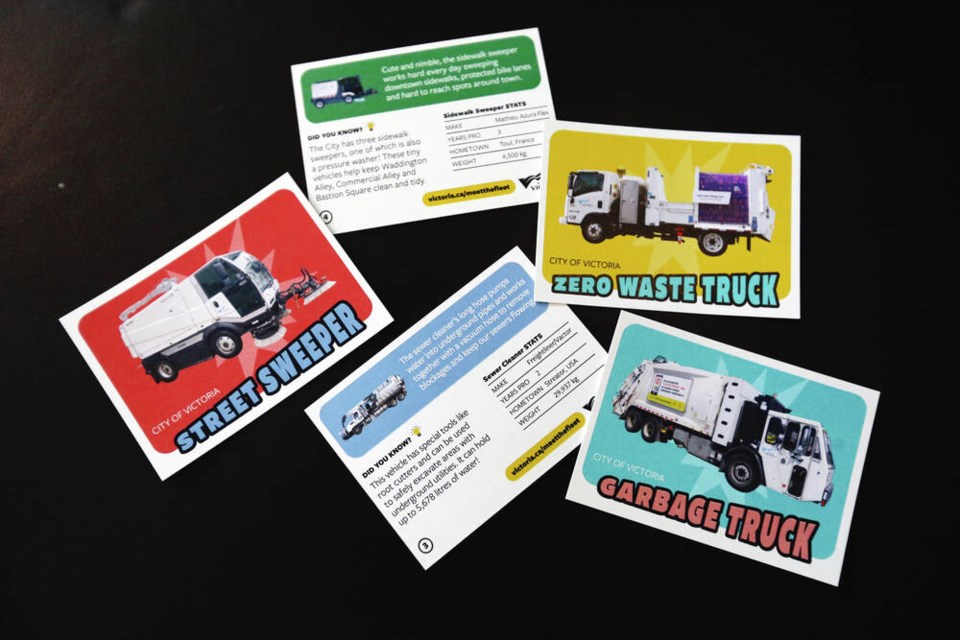To commemorate the past four years of Victoria city council, we are launching an unlimited edition of trading cards to draw attention to substantial unmet infrastructure needs.
We drew our inspiration from the city’s recent “Meet the fleet” trading card initiative that featured a sidewalk sweeper, sewer cleaner, zero waste truck, street sweeper and garbage truck.
We agree with the city: “Municipal infrastructure is vital in sustaining the economic, environmental, social and cultural life of our community.” We also agree that “the quality of life enjoyed by our citizens is directly related to the condition of the infrastructure.”
These gimmicky trading cards fly in the face of struggling taxpayers who expect the council will be good stewards of public money. So, our four-pack of cards — on pink slips of paper — showcases the inadequate funding levels for city roads, facilities and vehicle fleet.
BUMPY MAJOR ROADS. Mayor Lisa Helps recently defended council’s track record on fixing roads since 2015, saying council has invested more in road paving and repairs than any time in the city’s history. Adding: “Unfortunately, we’ve got decades of catching up to do.”
After eight years in office, why still decades behind? Residents, visitors, tourists, walkers, cyclists, the mobility-challenged, along with drivers of emergency vehicles, taxis and buses have first-hand experience with our substandard roads.
The city’s own reports on the current status of community assets suggests that roads are deteriorating from ongoing wear and extreme weather events quicker than they are being fixed and upgraded.
The city’s 2013 road assessment report notes 13 per cent of major or arterial roads are in fair/poor condition. The city’s 2018 road assessment report, done by a different firm, notes 27 per cent of 106 kilometres of major roads are in fair/poor condition.
CRATERED LOCAL ROADS. Drivers know that whatever the city has spent on paving and repairs, it’s been inadequate. The costs of fixing roads will now likely face substantial inflationary pressures brought on by higher gas, material and labour costs.
The 2013 road assessment report notes 20 per cent of local roads are in fair/poor condition. The 2018 road assessment report notes 34 per cent of 173 kilometres of local roads are in fair/poor condition.
An updated road condition assessment report for all roads is expected to be completed this summer by the company that did the 2013 report. An updated pavement management plan is needed sooner rather than later.
FAILING FACILITIES. As for 100 or so facilities, a complete condition assessment was last undertaken in 2015. An overall facilities master planning process for the city — Saanich is guided by a 20-year Strategic Facilities Master Plan completed in 2018 — has begun, but it’s not completed yet.
So we don’t know the overall current condition, the priorities or the cost to taxpayers of critical infrastructure such as the nine community centres and five recreation buildings. Nor the condition of the city administration buildings including city hall, public works and yard, and so on.
During the past two city hall administrations, council failed to deliver a Crystal Pool replacement. Condition assessments in 2011, 2014 and 2015 confirmed the place is in shambles and very expensive to maintain and operate.
The controversial pool replacement is now dead in the water — its condition is rated at 65 per cent poor — and council is content to keep patching the place up.
It’s encouraging that council will deliver a new Fire Hall No. 1 this year or next for about $33.7 million.
FOSSIL-FUEL BURNING FLEET. Maybe these goofy trading cards are designed somehow to soften the blow for the years ahead.
The city has recently focused on replacing and rehabilitating its fleet of about 400 vehicles. But it’s a huge task that will require millions more — more than $16 million in the next three years.
The city has a Green Fleet Plan that will replace 143 fleet vehicles with electric options over the next nine years. It’s phasing out the existing fossil-fuel-burning fleet and transitioning to electric and renewable fuel in order to help meet climate goals. Electrical vehicle infrastructure costs are put at $6.8 million in the next three years.
Clearly, some fiscal discipline and more sensitivity needs to be shown to taxpayers to achieve these goals. Could costs be reduced with co-operation across 13 municipalities? Can anyone answer that question?
Many residents and businesses are experiencing hard times and have just received their city tax notice.
There’s no relief in sight with inflation running at 6.8 per cent and wage gains averaging 3.4 per cent.
Baubles and trinkets such as the musical parkade staircase, a ping-pong table and, now, trading cards, suggest city hall has lost touch with its electorate. After adding in-house labour, the trading cards cost only a few thousand, but the optics of spending these precious tax dollars is illuminating.
Who cares if a sidewalk sweeper is “cute and nimble” and made in Toule, France? Cash-strapped taxpayers care more that bumpy Blanshard Street downtown is rebuilt.



